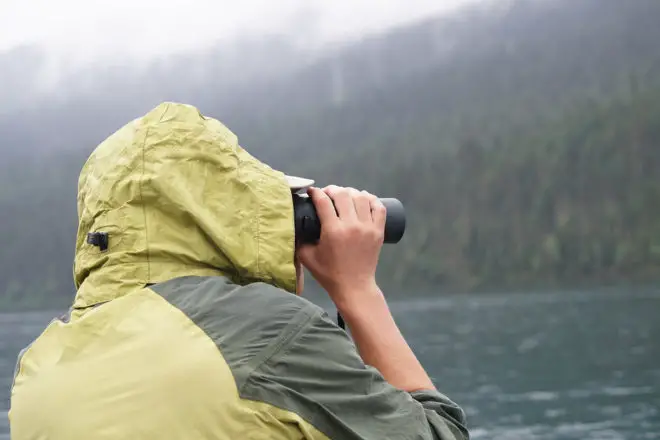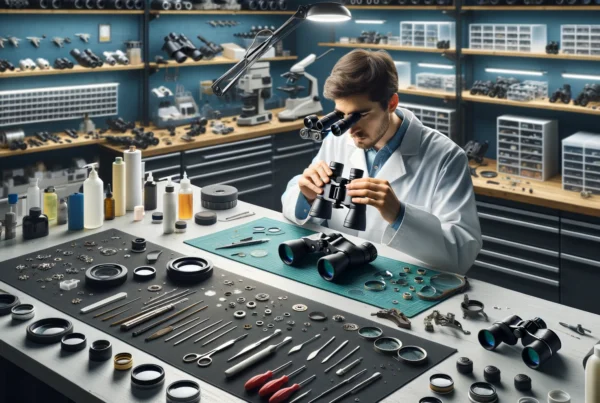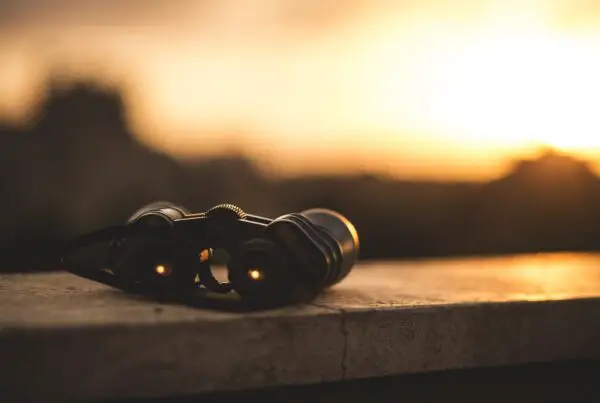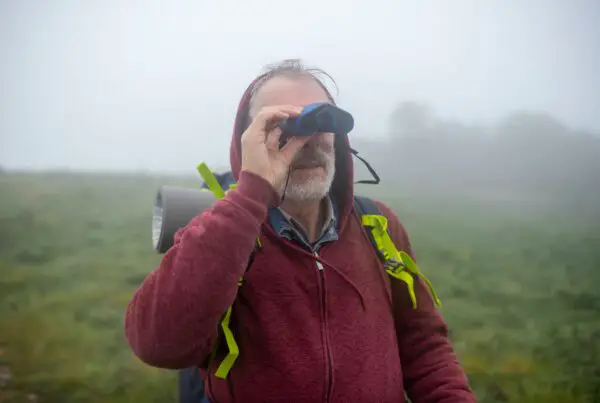Contents
Exploring the great outdoors with a pair of binoculars is an exhilarating experience, but when Mother Nature throws her most extreme weather conditions your way, the challenge becomes even greater. From torrential rain to blinding snowstorms, and gusty winds to scorching heat, these conditions can put both you and your binoculars to the test.
When using binoculars in extreme weather conditions, choose weather-resistant models with features like waterproofing and fog-proofing. Protect the lenses with covers or caps, and carry a waterproof bag or case. Regularly clean the lenses and adjust the eye relief and focus for optimal viewing.
However, with the right techniques and preparations, you can conquer the elements and make the most of your binoculars. In this article, we’ll share some invaluable tips to help you harness the power of your binoculars in the face of extreme weather conditions.
#1: Selecting Weather-Resistant Binoculars
A. Features to Look For
- Waterproof Design: Opt for binoculars with a waterproof construction to protect them from rain, splashes, or accidental submersion. Look for an IPX7 or IPX8 rating for reliable waterproof performance.
- Fog-Proof Capability: Seek binoculars with fog-proof features such as nitrogen or argon gas purging. This prevents internal fogging, ensuring clear visibility even in humid or temperature-changing environments.
- Robust Materials: Consider binoculars made from durable materials like rubber-armored coatings or magnesium alloy chassis. These materials provide protection against impact, scratches, and general wear and tear.
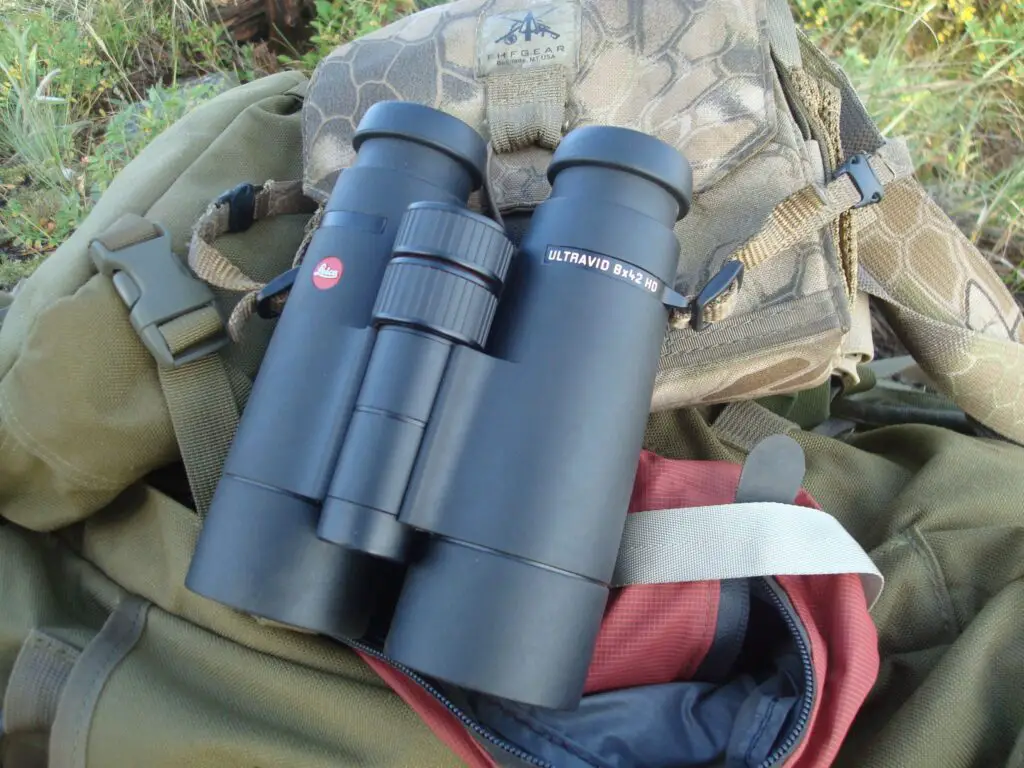
B. O-ring Seals and Purging Techniques
- O-ring Seals: O-ring seals create a tight barrier that prevents water, moisture, and debris from entering the binocular’s interior. These seals ensure that your binoculars remain watertight and well-protected.
- Purging Techniques: Binoculars with purged air, filled with dry nitrogen or argon gas, eliminate internal moisture and maintain a clear view. This purging process significantly reduces the chances of fogging or condensation.
C. Benefits of Weather-Resistant Binoculars
- Enhanced Durability: Weather-resistant binoculars are built to withstand challenging outdoor conditions. They offer longevity and reliability, ensuring your investment lasts for years.
- Versatile Usage: With weather-resistant binoculars, you can confidently explore various environments, including rainy jungles, snowy mountains, or humid coastal areas.
- Clear Optics in Adverse Conditions: These binoculars provide excellent optical performance even in extreme weather. They are designed to maintain sharpness, clarity, and contrast in rain, fog, or high humidity.
- Peace of Mind: Weather-resistant binoculars provide peace of mind, allowing you to focus on your outdoor adventure without worrying about potential damage to your equipment.
#2: Shielding Your Optics
A. Importance of Lens Protection
- Preserving Optical Quality: The lenses are crucial for delivering clear and detailed views. Protecting them from dust, moisture, and scratches ensures optimal optical performance.
- Prolonging Lifespan: Shielding the lenses extends their lifespan, preventing damage that could affect image quality and require costly repairs or replacements.
B. Using Lens Covers or Caps Effectively
- Utilize Properly-Fitting Covers: Invest in lens covers or caps specifically designed for your binoculars. These accessories provide a physical barrier against dust, moisture, and debris.
- Keep Covers on When Not in Use: Whenever you’re not actively observing, keep the lens covers or caps securely in place. This prevents accidental contact with objects and minimizes the risk of scratches or smudges.
- Remove Covers Swiftly: When you spot something of interest, remove the lens covers quickly to avoid missing the moment. Practice smooth and efficient removal to ensure immediate access to the lenses.
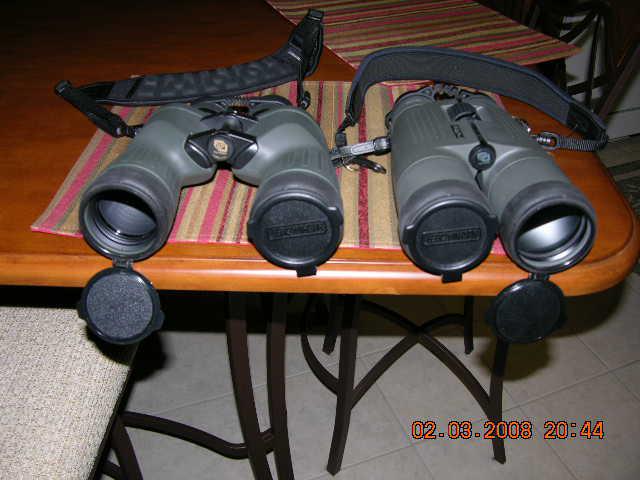
C. Swift Access to Lenses for Immediate Use
- Be Prepared: Keep your binoculars within easy reach, ideally in a dedicated bag or harness that allows for quick access. This ensures you’re ready to use them without delay.
- Practice Handling: Familiarize yourself with your binoculars’ design and mechanisms. Learn how to swiftly remove lens covers and extend the eye cups to facilitate immediate use.
- Develop Muscle Memory: Through regular practice, develop muscle memory for accessing the lenses. This enables you to react instinctively and capture unexpected moments promptly.
#3: Combating Moisture
A. Carrying a Waterproof Bag or Case
- Invest in a Waterproof Bag or Case: Use a bag or case specifically designed to protect your binoculars from water and moisture. Look for a waterproof rating or materials like neoprene or PVC that offer reliable protection.
- Secure Closure Mechanism: Ensure the bag or case has a secure closure mechanism, such as a zipper or buckle, to prevent water from seeping in. Additionally, check for any potential gaps or openings that could compromise its waterproofing capabilities.
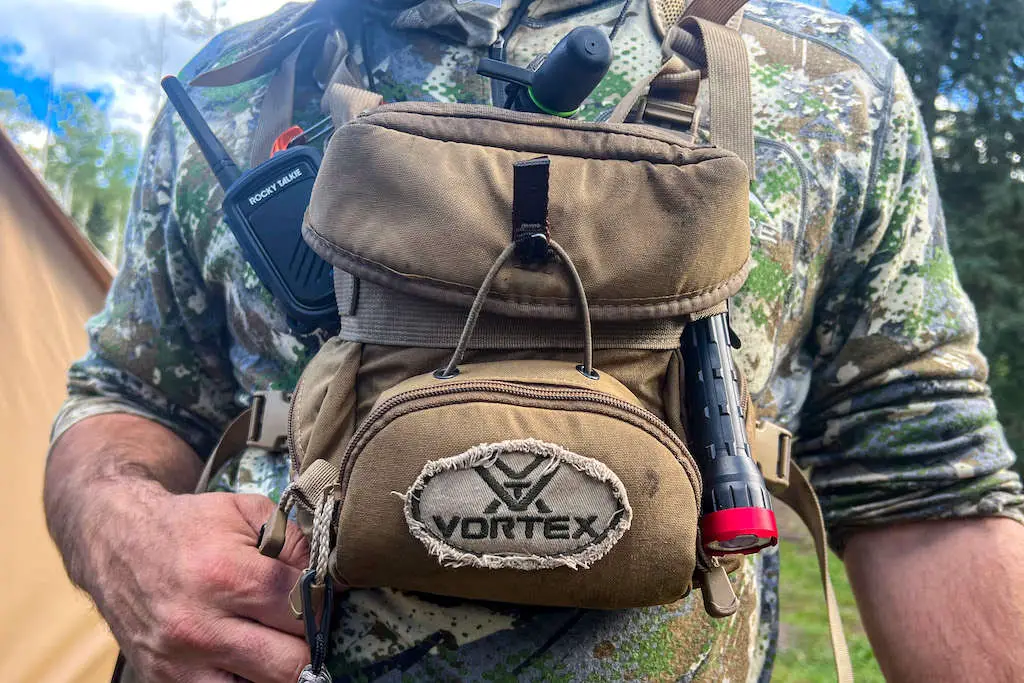
B. Drying Binoculars Thoroughly
- After Exposure to Moisture: If your binoculars get wet, promptly dry them off using a soft, absorbent cloth. Pay particular attention to the lenses, eyepieces, and exposed parts where water may accumulate.
- Air Drying: After wiping off any visible moisture, leave your binoculars in a well-ventilated area to air dry completely. Avoid exposing them to direct sunlight or heat sources, as this may damage the optics or other components.
C. Preventing Damage and Fogging
- Moisture-Absorbing Packets: Place moisture-absorbing silica gel packets in the bag or case where you store your binoculars. These packets help absorb excess moisture, preventing condensation and potential fogging.
- Avoid Sudden Temperature Changes: Minimize exposing your binoculars to rapid temperature changes. Extreme temperature shifts can cause condensation on the lenses, affecting visibility and potentially damaging internal components.
- Use Lens Cleaning Tools: Regularly clean the lenses with a lens brush or air blower to remove dust and moisture. Additionally, use a microfiber cloth to gently wipe away smudges or fingerprints, ensuring clear and unobstructed views.
#4: Regular Cleaning
A. Essential Lens Cleaning Kit
- Lens Brush: A lens brush with soft bristles is ideal for removing loose particles such as dust, dirt, or sand from the lenses. Gently brush the surfaces to avoid scratching.
- Air Blower: An air blower is useful for blowing away stubborn particles that may be stuck on the lenses or other parts of the binoculars. The forceful burst of air helps dislodge debris without the risk of scratching.
- Microfiber Cloth: A microfiber cloth is a must-have for cleaning the lenses. Its ultra-soft texture effectively removes smudges, fingerprints, and other marks without leaving lint or scratches.
B. Removing Loose Particles Before Wiping Lenses
- Use the Lens Brush: Before using the microfiber cloth, gently brush the lenses and other surfaces to remove any loose particles. This step helps prevent scratches during the cleaning process.
- Target Specific Areas: Pay attention to areas where dust or debris tend to accumulate, such as around the eyepieces or focus wheel. Use the brush to carefully clean these spots.
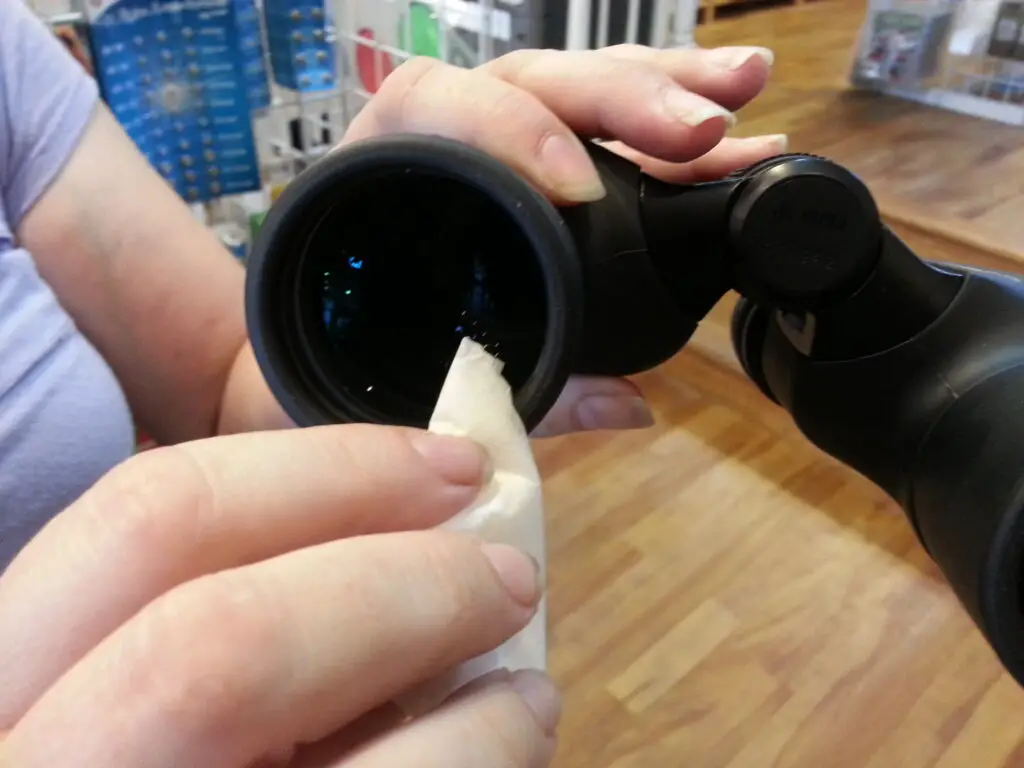
C. Maintaining Optimal Image Clarity
- Use a Gentle Touch: When using the microfiber cloth, apply light pressure and use gentle circular motions to wipe the lenses. Avoid excessive force, as it can potentially damage the delicate lens coatings.
- Start from the Center: Begin cleaning from the center of the lenses and gradually move outward in a spiral motion. This ensures even cleaning and reduces the risk of pushing debris towards the lens edges.
- Avoid Harsh Cleaning Agents: Refrain from using harsh cleaning solutions or chemicals on your binocular lenses, as they can damage the coatings. Stick to the microfiber cloth or, if needed, use a lens cleaning solution specifically designed for optics.
#5: Adjusting Eye Relief and Focus
A. Effects of Fluctuating Temperatures on Rubber Eyecups
- Understand Rubber Eyecup Behavior: Rubber eyecups on binoculars can expand or contract with temperature changes. In colder temperatures, they may become stiffer and less pliable, while in hotter conditions, they may become softer and more flexible.
- Adapt to Temperature Changes: Be aware of how the rubber eyecups on your binoculars respond to temperature fluctuations. Adjust them accordingly for optimal comfort and to maintain a proper viewing distance from the eyepieces.
B. Importance of Adjusting Settings for Comfort
- Eye Relief Adjustment: Eye relief refers to the distance between your eyes and the eyepieces. Adjusting the eye relief ensures that you have a comfortable viewing experience, especially if you wear glasses.
- Diopter Adjustment: Many binoculars have a diopter adjustment, which allows you to compensate for differences in vision between your left and right eye. Set the diopter according to your eyesight to achieve a balanced and sharp view.
C. Swift Adjustments for Capturing Captivating Subjects
- Know Your Binoculars’ Focus Mechanism: Familiarize yourself with the focus mechanism of your binoculars. It may have a central focus wheel or individual focus adjustments for each eyepiece.
- Practice Swift Focus Adjustments: Develop the skill to quickly and accurately adjust the focus to capture fleeting moments or fast-moving subjects. Regular practice will enable you to react swiftly and maintain focus on captivating scenes.
#6: Dressing Appropriately
A. Choosing Clothing for Insulation, Breathability, and Protection
- Insulation: Layer clothing appropriately to regulate body temperature in extreme weather conditions. Opt for thermal base layers, insulating mid-layers, and a waterproof and windproof outer shell to stay warm.
- Breathability: Choose clothing made from breathable fabrics to prevent overheating and excessive sweating. Moisture-wicking materials help keep you dry and comfortable during strenuous activities.
- Protection: Consider clothing with built-in sun protection (UPF) to shield your skin from harmful UV rays. Additionally, wear a wide-brimmed hat, sunglasses, and sunscreen for added protection.
B. Selecting Gloves with Dexterity and Grip
- Dexterity: Look for gloves that offer dexterity, allowing you to manipulate the controls and adjustments on your binoculars easily. Opt for gloves with articulated fingers or those specifically designed for outdoor activities.
- Grip: Choose gloves with textured palms or silicone grips to ensure a secure hold on your binoculars, even in wet or slippery conditions. This enhances stability and reduces the risk of accidentally dropping your equipment.
C. Ensuring Comfortable Handling of Binoculars
- Strap or Harness: Use a comfortable and adjustable strap or harness to carry your binoculars. This distributes the weight evenly across your body, reducing strain on your neck and providing easy access when needed.
- Padding: Consider using padded accessories, such as shoulder pads or neck straps, for added comfort during extended use. The padding helps reduce discomfort and fatigue.
- Secure Attachment: Ensure your binoculars are securely attached to the strap or harness to avoid accidental drops. Double-check the connections before embarking on your outdoor activities.
#7: Stabilizing for Steady Viewing
A. Using Tripods or Monopods for Stability
- Tripods: Consider using a tripod designed for binoculars to achieve maximum stability. Tripods provide a solid and steady base, minimizing hand-held shake and allowing for extended periods of comfortable viewing.
- Monopods: If a tripod is not practical or convenient, a monopod can offer some stability. While not as stable as a tripod, a monopod provides additional support compared to hand-holding the binoculars.
B. Resting Binoculars on Stable Surfaces
- Utilize Natural Supports: Look for stable surfaces such as rocks, tree branches, or benches to rest your binoculars. This helps reduce hand tremors and provides a steadier view.
- Use Bean Bags or Cushions: Consider using a bean bag or cushion to rest your binoculars on when there are no stable surfaces available. These soft supports can help stabilize your view and minimize shake.
C. Enhancing View Clarity and Reducing Shake
- Adjust Eye Relief: Ensure that the eye relief is set correctly for your eyes to achieve a full field of view. This helps maintain a stable image and reduces the need for constant readjustment.
- Activate Image Stabilization: If your binoculars are equipped with image stabilization technology, utilize this feature to further reduce shake and enhance view clarity.
- Control Your Breathing: Practice deep and controlled breathing techniques while observing through binoculars. This helps minimize movement and shake caused by your own body.
#8: Patience and Adaptability
A. Dealing with Reduced Visibility in Extreme Conditions
- Be Prepared Mentally: Understand that extreme weather conditions can affect visibility, such as fog, rain, or low light. Mentally prepare yourself to adapt and make the most of the available conditions.
- Adjust Expectations: Realize that in challenging weather, you may need to lower your expectations for long-distance or detailed observations. Focus on enjoying the experience rather than solely relying on specific outcomes.
B. Scanning the Area Slowly and Thoroughly
- Take Your Time: Slow down your scanning pace to thoroughly observe the area. Rushing can cause you to miss subtle details or potential wildlife.
- Utilize a Systematic Approach: Divide the area into sections and scan each section methodically. Start from one side and move systematically across, ensuring you cover the entire field of view.
C. Allowing Time for Eyes to Adjust and Spot Subtle Signs
- Give Your Eyes Time to Adapt: In low-light conditions, allow your eyes to adjust before attempting to spot objects or wildlife. Give yourself a few minutes to allow your pupils to dilate and improve your night vision.
- Look for Subtle Signs: Train your eyes to look for subtle signs of movement, color contrast, or shapes that indicate the presence of wildlife. Pay attention to the smallest details and use your binoculars to enhance your observations.
#9: Prioritizing Safety
A. Recognizing Personal Well-being as Paramount
- Safety First: Remember that your personal well-being should always be the top priority. Assess the risks associated with extreme weather conditions and make informed decisions accordingly.
- Stay Hydrated and Nourished: Ensure you drink plenty of water and consume adequate food to maintain your energy levels during outdoor activities. Extreme weather can be physically demanding, so take care of your body’s needs.
B. Avoiding Risky Weather Conditions
- Stay Informed: Keep track of weather forecasts and be aware of any severe weather warnings or advisories in your area. Plan your outings accordingly and avoid venturing out during hazardous conditions.
- Lightning Safety: In thunderstorm-prone areas, be cautious when using binoculars outdoors. Seek shelter immediately if you hear thunder or see lightning flashes, as being exposed in open areas can be dangerous.

C. Choosing Sheltered Locations for Binocular Usage
- Seek Protective Cover: Look for sheltered areas such as gazebos, tree canopies, or overhangs to use your binoculars. These locations provide protection from rain, snow, or harsh sunlight, ensuring your comfort and the longevity of your equipment.
- Use Natural Features: Utilize natural features like cliffs, rock formations, or tall vegetation to shield yourself from strong winds or adverse weather conditions. These features can act as a barrier and offer some protection during your observation.
Frequently Asked Questions (FAQs)
Here are some frequently asked questions (FAQs) and answers about using an air fryer for the first time:
Q: Can I use regular binoculars in extreme weather conditions?
A: Regular binoculars may not be suitable for extreme weather conditions. It is recommended to invest in weather-resistant binoculars that are waterproof, fog-proof, and made with robust materials to withstand challenging environments.
Q: How do I protect the lenses of my binoculars in extreme weather?
A: Use lens covers or caps to protect the lenses from moisture, dust, and scratches. Ensure they are securely attached and easily accessible. Consider carrying a microfiber cloth to wipe away any debris before using the binoculars.
Q: What should I do if my binoculars get wet?
A: If your binoculars get wet, dry them thoroughly as soon as possible. Use a soft cloth to remove excess moisture and let them air dry in a well-ventilated area. Avoid exposing them to direct heat sources.
Q: Are there any specific techniques to adjust binocular settings in extreme temperatures?
A: Fluctuating temperatures can affect rubber eyecups. Be aware of their behavior and adjust them for comfort. Also, allow time for your binoculars to adjust to temperature changes before making precise focus adjustments.
Q: Can I use binoculars during thunderstorms or heavy rain?
A: It is not recommended to use binoculars during thunderstorms or heavy rain due to the risk of water damage and potential harm from lightning. Seek shelter in such conditions to ensure personal safety.
Q: How do I ensure a steady view when using binoculars in windy conditions?
A: Use tripods or monopods for added stability, or rest your binoculars on stable surfaces such as rocks or tree branches. Additionally, consider using image stabilization features if your binoculars have them.
Bottom Line
With the right approach and preparation, extreme weather conditions need not hinder your binocular usage or dampen your passion for exploration. By selecting weather-resistant binoculars, protecting your optics, and adapting your techniques to suit the conditions, you can unlock breathtaking experiences even in the face of nature’s most challenging moments.
Stay safe, embrace the elements, and immerse yourself in the wonders that await through your binocular lenses.

A Binoculars enthusiast, who love exploring skies and watching birds. It is my hobby to collect Binoculars of different kinds and try to explore the world through various lenses. This is all I do to explore happiness by magnifying my beautiful world.

